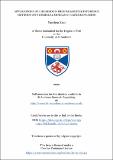Files in this item
Applications of likelihood-free parameter inference methods on numerical models of cancer invasion
Item metadata
| dc.contributor.advisor | Thomas, Len | |
| dc.contributor.advisor | Chaplain, Mark | |
| dc.contributor.author | Xiao, Yunchen | |
| dc.coverage.spatial | vi, 194, A135 p. | en_US |
| dc.date.accessioned | 2022-09-06T08:15:18Z | |
| dc.date.available | 2022-09-06T08:15:18Z | |
| dc.date.issued | 2022-07-27 | |
| dc.identifier.uri | https://hdl.handle.net/10023/25952 | |
| dc.description.abstract | In this thesis, we present two different methods to estimate parameters within a Partial Differential Equation (PDE) model of cancer invasion and an Individual-based Model (IBM) derived from it. The PDE model was fitted to synthetic spatial 1D data generated from the model, and the IBM was fitted to authentic spatial 2D data derived from the invasion patterns observed in in vitro and ex vivo organotypic assays. The first estimation method is a likelihood-free approach related to Approximate Bayesian Computation (ABC). The second is a two-stage gradient matching method based on smoothing the data with a Generalized Additive Model (GAM) and matching gradients from the GAM to those from the model. Both methods performed well on spatial 1D synthetic data when the synthetic data was generated assuming no measurement errors. To increase realism we tested both methods with simulated measurement errors, and found that the ability to estimate some model parameters deteriorated rapidly as measurement error increased for the gradient matching method. The ABC method was more robust to the introduction of measurement errors. For spatial 2D authentic data, we only applied the ABC method. The simulated patterns produced at the end of the estimation procedure were quantitatively close to the observed ones. In addition, most of the final parameter samples obtained in the spatial 2D inference passed a set of ABC posterior diagnostics, implying they are valid posteriors from the perspective of Bayesian inference. The ABC-derived calibration methods developed in this thesis are not limited to models of cancer invasion alone, and can potentially be applied in a wide variety of application areas where the system under examination can be described using PDE models. | en_US |
| dc.language.iso | en | en_US |
| dc.relation | Applications of likelihood-free parameter inference methods on numerical models of cancer invasion (thesis data) Xiao, Y., University of St Andrews, 16 August 2022. DOI: https://doi.org/10.17630/f2a34bdc-d9a0-4dcf-8eb1-9d6c1a79af95 | en |
| dc.relation.uri | https://doi.org/10.17630/f2a34bdc-d9a0-4dcf-8eb1-9d6c1a79af95 | |
| dc.rights | Creative Commons Attribution-NonCommercial-NoDerivatives 4.0 International | * |
| dc.rights.uri | http://creativecommons.org/licenses/by-nc-nd/4.0/ | * |
| dc.subject | Mathematical biology | en_US |
| dc.subject | Bayesian statistics | en_US |
| dc.subject.lcc | QH323.5X5 | |
| dc.subject.lcsh | Biology--Mathematical models | en |
| dc.title | Applications of likelihood-free parameter inference methods on numerical models of cancer invasion | en_US |
| dc.type | Thesis | en_US |
| dc.contributor.sponsor | Engineering and Physical Sciences Research Council (EPSRC) | en_US |
| dc.contributor.sponsor | University of St Andrews. St Leonard's Fee Scholarship | en_US |
| dc.type.qualificationlevel | Doctoral | en_US |
| dc.type.qualificationname | PhD Doctor of Philosophy | en_US |
| dc.publisher.institution | The University of St Andrews | en_US |
| dc.identifier.doi | https://doi.org/10.17630/sta/195 |
The following licence files are associated with this item:
This item appears in the following Collection(s)
Except where otherwise noted within the work, this item's licence for re-use is described as Creative Commons Attribution-NonCommercial-NoDerivatives 4.0 International
Items in the St Andrews Research Repository are protected by copyright, with all rights reserved, unless otherwise indicated.


